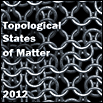Speaker
Jerome Cayssol
(Max Planck Institute for the Physics of Complex Systems)
Description
Various Fractional Quantum Hall (FQH) states were recently
reported in graphene under a strong magnetic field. Those
FQH phases result from the effect of enhanced interactions
between electrons moving in partially filled flat Landau
levels, and exhibit remarkable properties (fractional
quasiparticles with richer statistical properties than usual
fermions or bosons, ground state degeneracy, ...).
I will talk about electronic phases in strained graphene in
the absence of magnetic field. The strain generates nearly
uniform pseudo magnetic fields which are opposite for the
two valleys of graphene. The non-interacting part of our
model describes the zero magnetic field pseudo Landau level
(PLL) structure recently proposed [1] and experimentally
reported [2] in strained graphene. Since the reported
effective magnetic fields [2] range from 60 T up to 300 T,
the interaction-driven phases might conceivably be realized
with larger energy gaps than in FQH states under a real
magnetic field. Besides strained graphene, our results also
pertain for artificial graphenes such as patterned electron
gases and cold atoms in hexagonal lattices.
More specifically, we have investigated the zero energy PLL
at 2/3 filling [3]. In presence of the unscreened Coulomb
interaction, electrons realize a 2/3 Hall state breaking time-
reversal symmetry. Upon tuning the local part of the
interaction, this 2/3 state can be destabilized towards a
time-reversal symmetric state realizing a 1/3 Laughlin state
in each valley. This state has a 9-fold ground state
degeneracy and can be seen as a valley fractional topological
insulator (FTI). For local attractive interactions, the
1/3+1/3 FTI has a transition towards a superconducting
state. On raising the filling to the neutrality point, namely
for the half-filled zero energy PLL, we find either a
ferromagnet or a valley polarized state depending on the
strength of the on-site interactions.
[1] F. Guinea, M.I. Katsnelson, and A.K. Geim, Energy gaps
and a zero-field quantum Hall effect in graphene by strain
engineering, Nat. Phys. 6, 30 (2010).
[2] L. Levy et al., Strain-induced pseudomagnetic fields
greater than 300 tesla in graphene nanobubbles, Science
329, 544 (2010).
[3] P. Ghaemi, J. Cayssol, D. N. Sheng and A. Vishwanath,
Fractional topological phases and broken time reversal
symmetry in strained graphene, Phys. Rev. Lett. 108,
266801 (2012).

